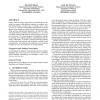Free Online Productivity Tools
i2Speak
i2Symbol
i2OCR
iTex2Img
iWeb2Print
iWeb2Shot
i2Type
iPdf2Split
iPdf2Merge
i2Bopomofo
i2Arabic
i2Style
i2Image
i2PDF
iLatex2Rtf
Sci2ools
113
click to vote
GIS
2008
ACM
2008
ACM
Sparse terrain pyramids
Bintrees based on longest edge bisection and hierarchies of diamonds are popular multiresolution techniques on regularly sampled terrain datasets. In this work, we consider sparse terrain pyramids as a compact multiresolution representation for terrain datasets whose samples are a subset of those lying on a regular grid. While previous diamond-based approaches can efficiently represent meshes built on a complete grid of resolution (2k +1)2 , this is not suitable when the field values are uniform in large areas or simply non-existent. We explore properties of diamonds to simplify an encoding of the implicit dependency relationship between diamonds. Additionally, we introduce a diamond clustering technique to further reduce the geometric and topological overhead of such representations. We demonstrate the coherence of our clustering technique as well as the compactness of our representation. Categories and Subject Descriptors I.3.5 [Computer Graphics]: Computational Geometry and Objec...
Related Content
| Added | 09 Nov 2010 |
| Updated | 09 Nov 2010 |
| Type | Conference |
| Year | 2008 |
| Where | GIS |
| Authors | Kenneth Weiss, Leila De Floriani |
Comments (0)

